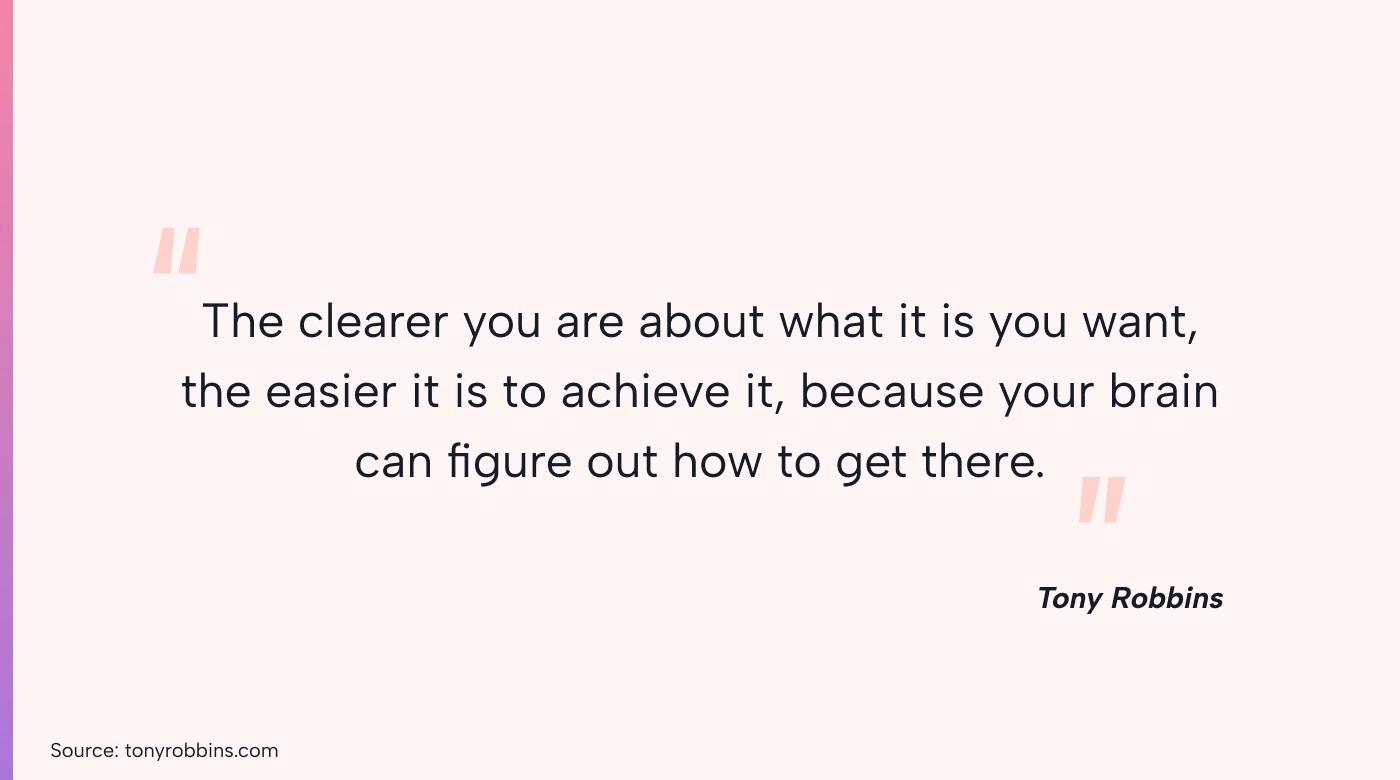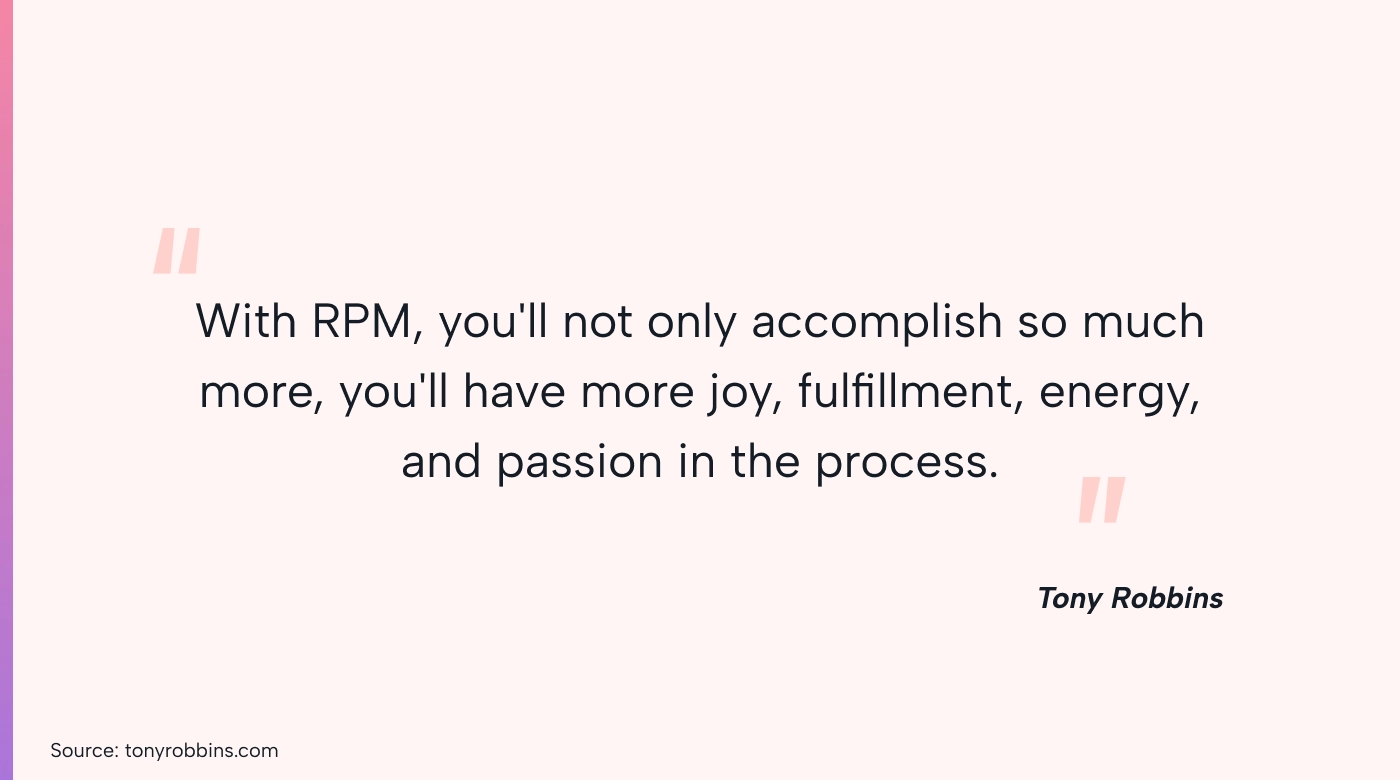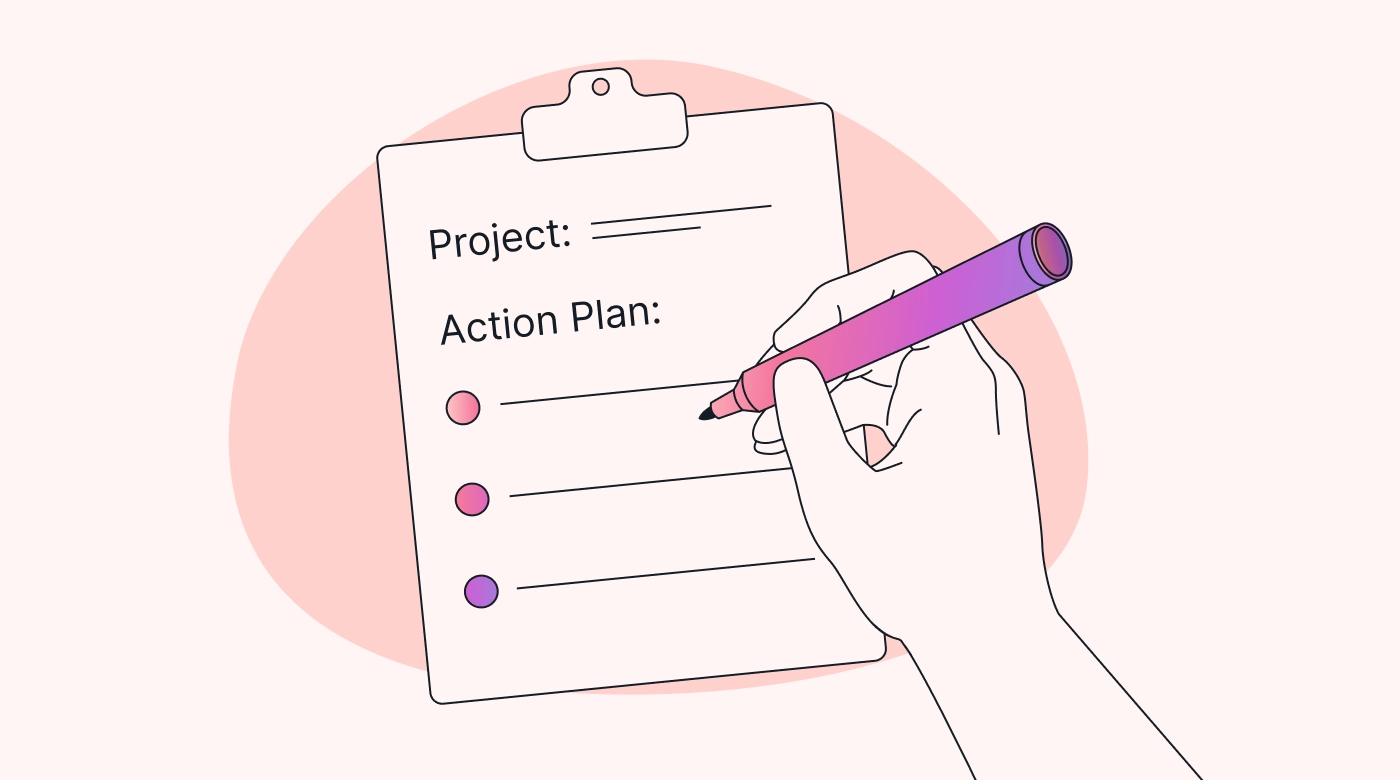Do you ever feel like your to-do list is never-ending — getting longer instead of shorter without ever leading to a true sense of accomplishment?
If so, take a look at the Rapid Planning Method (RPM™), a transformative goal-setting approach that shifts your focus from merely ticking off tasks on your list to achieving fulfilling, purpose-driven results.
Whether you use it in your personal life or at work, the RPM empowers you to align your daily efforts with meaningful objectives and helps you turn every action into a step toward greater success.
What is the Rapid Planning Method?
The Rapid Planning Method (RPM), developed by American entrepreneur, motivational speaker, business strategist, and best-selling author Tony Robbins, is a purpose-driven planning system designed to help people achieve their goals more effectively and, ultimately, live a more fulfilling life.
The best way to describe the RPM is as a holistic approach to planning that considers not only the tasks at hand but also the underlying motivations for accomplishing important objectives.
Robbins developed this system for himself in 1978 and has used it ever since as part of his success-in-life strategy. His website tells the story of how RPM came about:
“Like many people, Tony had huge dreams about what he could accomplish in life and wasn’t satisfied just thinking about it. He needed a simple, clear, step-by-step system for successfully achieving his goals. That’s when he created the RPM™ System and applied it in his life. It changed his way of thinking and that caused him to focus on the results rather than tasks and associate them to his purpose. Once he made that shift, he experienced massive success.”
How does the RPM work?
The underlying premise of the RPM method is that in order to be successful in life, you have to be crystal clear about what you want to achieve.
 |
Robbins’ philosophy is that a compelling reason and purpose are strong enough motivators to keep you focused on the success you are looking for.
He says, “What’s most important to you as an outcome (a result) and why it is important to you (your purpose) will give you the juice to move forward toward realizing your dreams.”
That’s why Robbins calls RPM a system of thinking rather than a time-management system. The goal is not to manage your to-do list more efficiently but to create a more fulfilling life for yourself.
The RPM follows a set of clearly defined steps to achieve this outcome. Here’s how it works:
1. Ask yourself three critical questions
Begin by asking yourself what you really want.
This can be a high-level goal (“I want to get married and have seven children”) or a more immediate goal (“I want to take a 2-week vacation in Italy with my boyfriend this summer”).
It’s important to be very specific when you answer this question so that your desired outcome is as clear as possible and something you can easily visualize.
Next, articulate the reasons and purpose behind what you want.
Why is achieving this outcome important to you? What bumps it from a “could-do” or “maybe should-do” to an absolute “must-do”?
The reason gives you a mental explanation of why you want what you want. The purpose, on the other hand, helps you tap into your feelings, which are a stronger driving force than what an intellectual explanation alone can do for you.
As you answer this second question, dig deep to get to the emotional core of what you want.
For instance, your superficial reason for wanting to go to Italy with your boyfriend could be that the two of you need some time together and like to travel. But a more compelling purpose could be that your family came from Italy four generations back and that you really want to go there so you can better understand your roots and personality — before feeling confident about moving the relationship with your boyfriend to the next step.
Identifying and articulating a deep underlying purpose like this will lend stronger motivational power to your goal, so you know you’ll stick with it and see it through to the intended outcome.
The last key question in this stage is, “What do I need to do to attain or achieve this thing that I really want?”
The answer to this question leads to the next step: creating an action plan.
2. Develop your Massive Action Plan
Now, it’s time to create what Robbins calls your Massive Action Plan (MAP).
A MAP is meant for not just the task at hand (for example, planning your Italy trip) but also everything else that’s on your plate. Putting this broader context on paper will later help you isolate and pay extra attention to your “must-do” goals.
You’ll start your MAP by writing down everything you have to do in the week ahead. Create a random list, and then “chunk” the items.
“Chunking” means grouping similar tasks together. For instance, your list of tasks to complete this week could be chunked into work, recreation, health, relationships, shopping, and Italy trip planning.
 |
Grouping to-do items into these chunks, which Robbins calls “RPM blocks,” makes large goals more manageable and helps you focus on one set of tasks at a time.
Specifically, for each RPM block, you’ll list the result or outcome you want, the purpose you want to fulfill, and the action steps that will help you reach the desired outcome.
For example, an Italy trip RPM block could look like this:
- Purpose: To connect more deeply and authentically with my Italian roots.
- Reason: To better understand myself so I will be more confident I can develop and sustain a harmonious, healthy relationship with my boyfriend.
- Result: Two-week vacation in Italy this summer.
- MAP:
- Get my boyfriend to agree to go on this trip.
- Decide on the best dates.
- Research places to visit and plan the itinerary.
- Check with Dad’s relatives in Italy about visiting and/or staying with them.
- Brush up on my Italian.
- Get passports.
- Book flights.
- Book hotels.
- Rent a car.
Once you have the RPM block action items isolated from the rest of your day-to-day activities, you can organize them on a timeline to ensure you get everything done before the due date.
3. Create matching roles or identities
One of the fun elements of Robbins’ RPM system is creating a personal identity for an important RPM block that expresses, in a few choice words, what that block really means to you. Make this identity as exciting as you can so that it will motivate you to stay focused on that goal.
For instance, someone who wants to get married and have seven kids could refer to himself as a Tribal Chieftain or Village Elder.
 |
The woman in the Italy trip scenario could call herself a Family Detective or Ancestry Sleuth.
Robbins’ point with this is that once you’ve created an exciting identity for yourself for the goal you want to pursue, the action steps you’ll take to get to that goal are no longer a boring chore. Instead, they contribute meaningfully to your identity.
What are the benefits of the RPM?
The RPM comes with several key advantages that make it a powerful tool for both personal and professional goal-setting and achievement.
Here are some of these benefits:
- The RPM starts with you defining clear outcomes and understanding the “whys” behind them. This deep dive brings more clarity about what is truly important and generates a sense of purpose that ordinary to-do lists can’t provide.
- The RPM strengthens your motivation and engagement by ensuring your actions are seen and experienced as part of a larger, more meaningful journey.
- On a more practical level, the RPM’s emphasis on prioritization and “chunking” can lead to improved productivity, helping you organize your tasks in a way that keeps stress to a minimum and increases your likelihood of reaching your goal.
How effective is the RPM?
Robbins’ website states that he has used his RPM system consistently to build his business empire.
And that empire is impressive: “Tony is the owner or part-owner of 56+ businesses with combined sales of more than $6 billion a year, and still has the time and energy to contribute substantially to the causes that he cares most about.”
 |
In looking at this method more objectively, it’s clear that the effectiveness of RPM compared to other methodologies depends on the individual or organization’s specific needs, the nature of their goals, and even their working style.
The RPM’s unique strength lies in its focus on aligning your actions with a larger purpose, which can be especially motivating and effective for strategic planning and long-term goal achievement — whether for individual or organizational planning purposes.
RPM is outcome-focused and starts with the end in mind by emphasizing the purpose behind your tasks. This gives it a stronger motivational power than most time management techniques.
Like many time management tools, the RPM includes prioritization. But it goes beyond it by integrating these priorities into a broader vision and plan. This makes the RPM better-suited for long-term planning and aligning one’s daily actions with their larger goals.
How do you use the RPM for work?
To answer this question, let’s divide “work” into two groups: work done by business owners and work done by individual employees.
Work done by business owners
The RPM can be a transformative tool for business owners in setting up and directing their business.
Initially, it involves establishing a clear, compelling vision for the business and aligning this vision with the owner’s personal values and goals.
In doing so, the business direction will not just be financially driven but also deeply connected to the owner’s life purpose.
A fun personal identity, like Captain of the Ship, can help the business owner continue to pour their heart into what they have created.
Using the RPM, the owner can then translate this vision into specific, actionable objectives — the milestones on the path to achieving the larger vision.
The MAP component of the RPM comes into play when the owner identifies all possible strategies and actions to reach these objectives and then prioritizes them based on their potential impact and feasibility.
 |
This approach not only drives effective business growth but also keeps the owner’s passion and motivation alive.
Work done by individual employees
The RPM can be a powerful method for employees to stay motivated and focused, even in less stimulating work environments.
There are two aspects to this:
- Employees can identify how their roles and daily tasks contribute to the company’s larger goals. This can provide a sense of purpose and belonging that can motivate them to perform high-quality work.
- Employees can identify how what they do at work contributes to a personal life goal that motivates them to continually stay engaged. For instance, a nurse at a hospital may have a personal goal (RPM block) of becoming an expert in human resilience in the face of health challenges. That nurse’s work, even though it’s very demanding, will then become a constant learning environment that contributes to their life’s goals and motivates them to keep going.
The “chunking” aspect of RPM is particularly useful for managing workloads and maintaining focus. Employees break down their tasks into smaller, manageable segments and set mini-goals and deadlines. This approach reduces stress and makes progress more tangible.
Using RPM in their work means employees can transform routine tasks into a vehicle for personal development while also achieving their career aspirations.
Use Motion to manage your MAP
As a method that helps people identify and achieve meaningful objectives in life, RPM can be used both for personal and professional growth. However, it is best suited for longer-term and strategic planning.
To effectively manage the MAP component of the RPM, it’s helpful to use intelligent project management and calendar tools. Motion, for instance, can handle task setting and tracking with ease.
Want to experience for yourself how effective such a tool can be? Try Motion for free for 7 days.

A certified content writer and SEO strategist, Carla Groenewegen writes about success principles and practices aimed at SMBs and not-for-profit organizations.




